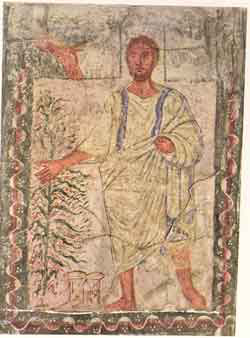Introduction
As early as 1872 there were archaeological hints of buried, painted buildings on a promontory overlooking a bend in the upper Euphrates River, half way between Beirut and Baghdad. In 1920, the site was identified conclusively as Dura, known also as Europos in Greek sources; a Roman garrison town, built on earlier Parthian and Hellenistic settlements. However, the fascinating excavation, that included more than fifteen temples scattered throughout the town, became a sensation in 1932, when a joint expedition of Yale University and the French Academy of Inscriptions and Letters uncovered a synagogue whose walls were daringly, brilliantly covered with frescoes, with human figures, dating to 244/5-256 CE.
Chance preserved these paintings. The town's western wall was the only direction from which an enemy could attack. As the Sassanian threat increased, the Roman defenders of Dura Europos filled in "Wall Street" and the buildings along it with dirt and debris in order to strengthen the town's defenses. Among these buildings was the synagogue. Those sections of the painted walls which were covered by the fill were spared; exposed areas, not protected by the fill, were water damaged, sometimes beyond identification. The diagrams below show the relationship between the synagogue's western wall to Wall Street and the city wall. In the upper picture, we see the beginning of dirt fill in Wall Street. The second and third pictures show the increasing height of the fill in Wall Street and in the synagogue, almost entirely covering the western wall, with less and less coverage of the remaining walls.
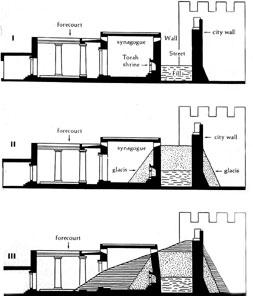
Prior to the discovery of the Dura Europos synagogue paintings, there was no evidence of Jewish figurative art in ancient times. As a result, the paintings are of monumental importance for art history, the study of Judaism and its relationship to Christianity and the hybridism of West and East—Roman and Persian cultures. Extensive figural decoration of similar complexity does not appear in Christian art until the 5th century. Understandably, well established scholarly theories were seriously challenged: Were in fact the origins of Christian art rooted in an antecedent, but now lost, Jewish art?(1) Was rabbinic Judaism of the 3rd century really so rigidly iconoclastic as scholars had assumed? Was rabbinic Judaism normative Judaism? Some of the answers to these questions will be forthcoming in the discussion below.
__________
(1) Weitzmann, K. and H. Kessler, The Frescoes of the Dura synagogue and Christian Art. Washington, D.C.: Dumbarton Oaks Research Library and Collection, 1990.
On Entering the Synagogue
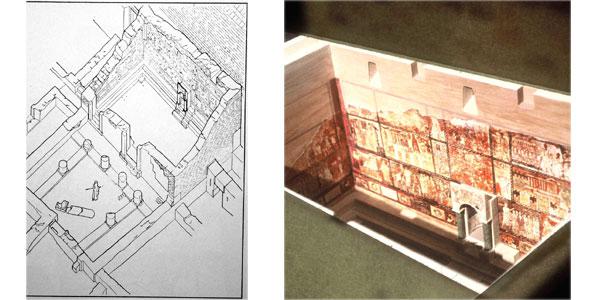
Imagine yourself, a Jewish traveler in the year 244, entering the newly decorated synagogue in the frontier town of Dura Europos on a Sabbath morning. You pass through an interior courtyard and a series of entry rooms to find yourself in a broad hall, 45 feet wide and 25 feet deep. The walls of the hall are entirely covered with life-size, brightly painted scenes from the Bible and at the center of the western wall, as expected, is the Holy Ark, in the form of a niche topped by a painted conch shell.
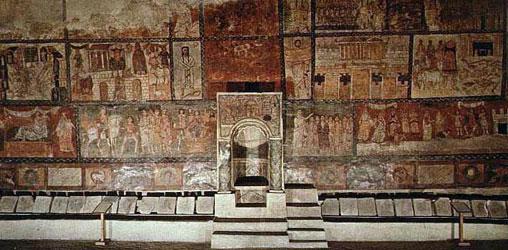
Immediately above the Ark is the image of the Temple, flanked by a menorah on one side and the Akeda on the other. On either side of the Ark you see images of your favorite stories of Moses, David, Elijah and Mordecai. Your overall impression is of astounding color, beauty, pride and prosperity. (See the exuberant description of the actual unearthing of the synagogue). You come closer to examine the details. What is the synagogue telling you? Gradually you see that the images are not random: there is an emphasis on the miraculous and the grand.
Archaeologists quickly realized that the synagogue's motifs were biblical, but only subsequently did scholars understand that these figures and stories were seen through the prism of midrash, sometimes known to us and sometimes obscure. But the Durenes always identified the biblical subjects with their own current reality, which is the way of midrash.
Scholarship has also recognized two major themes in the Dura Europos synagogue paintings: physical restoration and spiritual continuity, merging and overlapping. In other essays, we have treated the restoration theme by way of the rescue of the infant Moses, the Exodus and scenes from the Elijah saga; we have addressed the continuity theme by way of the Miraculous Desert Well and the Burning Bush, with the Akeda, the anointing of David and David as Messiah bridging the two themes.
Here we will treat an extended narrative band: the adventures of the Ark, whose image appears repeatedly over the entire length of the central register of the western and northern walls. Why is this narrative so prominent here?
We suggest that the images of the Ark narrative identify the current life of the Durenes with the biblical past. They are saying: the tabernacle/temple is like our synagogue, the Ark is like our ark, Moses is like our rabbi.
From Tabernacle to Temple to Synagogue

The congregation faces the Torah shrine on the western wall, the direction of Jerusalem. Just above the Torah niche and to either side, they see a band of paintings in which temples and their fixtures, including the Ark of the Covenant, appear over and over. Starting from the left, we recognize the painting of the Water Miracles, including one of the synagogue's many Moseses; in the picture to its right, we see Aaron, an impressive figure identified in Greek, standing within a building complex, together with additional people and three animals. In the panel to its right, Moses stands beneath the sun, moon and stars. Continuing on the far right (actually on the northern wall), we see the battle of Even Ha-ezer (I Samuel 4), in which the Ark is captured by the Philistines. The narrative continues to the left, on to the western wall, with the miraculous return of the Ark to Israel; continuing further to the left, a mysterious, static, closed Temple confronts us. Finally we reach yet another Moses reading from a Torah scroll, with the Ark beside him. Notice that we are reading the paintings from the outside in, both sides move to the center, focusing on the synagogue's own Torah shrine.
This central register of the synagogue's paintings is the most extended treatment of a single subject—the adventures of the Ark. Why was this subject so central for the congregation? Why are no fewer than five arks illuminated here? In our quest for answers, we will examine various elements of the pictures in this register.
In the our essay on the Desert Wanderings we discuss the first component of this register—the Water Miracles painting—a mysterious composite of visual midrash. The adjacent painting containing Aaron's image is equally mysterious and composite.
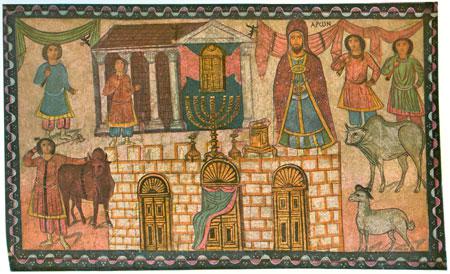
Aaron is elaborately costumed, unlike any other among the synagogue's figures. Five other figures, dressed in typical Persian style, fill various parts of the painting - four of them hold trumpets and one wields an axe. Three animals are also on stage: a bull, a ram and a "red heifer". Two structures occupy the center of the painting: at the bottom, a crenellated wall with three entrances and above, an edifice with Corinthian columns and a gabled roof. Despite the prominence of Aaron, it is not clear if this picture refers to a particular event, and if so, what event. The conventions of perspective and point of view established in the Renaissance are not employed here, complicating our understanding of the painting. In addition, the Durene painter(s) imaged biblical scenes in accordance with their own reality, which is often foreign to us. Nevertheless, scholars have concluded that the painting illustrates the holy precinct of the biblical desert sanctuary (the Mishkan) with the Tent of Meeting (ohel moed) at its center. The outer fence of this precinct, composed of goat skins, is represented here by three gates set into a stone wall at the lower part of the picture. A curtain partially covers the middle door, in accordance with Exodus 27:16. The three animals and one of the figures stand on either side of this wall, on a darker pink ground, indicating that they are outside the holy precinct. The upper part of the painting shows us the interior of the precinct.
The roofed temple is actually the Tent of Meeting. Although very similar to the way temples are pictured in all the synagogue's paintings, it is relatively small; it has no foundation, but is set directly on the ground, like a tent and its sides are painted brown, the color of the goat skins of which it was actually made.

The Tent's furnishings (menorah, etc.) stand in front of it, since this is the only way for us to see what is inside. Within the Tent, we see a partially curtained object - comparison with other paintings in the synagogue clarifies that this is the Ark of the Covenant (see below).
While some scholars have concluded that the subject of this painting is the consecration of Aaron and his sons (Leviticus 8), others understand it as the inauguration of the Tabernacle (Exodus 40 and Numbers 7). We suggest that the subject of the painting is better understood in dialogue with its neighbor on the left—the painting of the Water Miracles—and that these two paintings are a unit, describing two alternate views of the desert Tabernacle. One—the Water Miracle painting—focuses on the Tabernacle's legal and prophetic function, as the repository of the Torah, "the source of Living Water". The other—the Aaron painting—portrays the Tabernacle's ritual function, the site of Israel's sacrifices and the domain of its priests.

Both paintings are composites of several biblical texts and have similar square structures, despite their apparent differences. The Tent of Meeting is a gabled building, at the center of both paintings. The Menorah is framed in both by the Tent's opening, while other furniture of the Tent is seen alongside. In both, a large figure stands beside the Tent, while smaller figures populate the perimeter. But the two paintings also contain significant differences.
Whereas the Water Miracles painting portrays the Tent of Meeting within the square Israelite desert encampment, the Consecration scene focuses solely on the rectangular holy precinct with the Tent at its center. The miraculous water sources of Exodus and Numbers are understood midrashically as symbols of the Torah, whose streams lead from the Sanctuary to each individual tribe. Moses, wielding his staff, wears the Hellenistic himation, identifying him as teacher and Law giver. In the Tabernacle painting, Aaron wears the unique costume of the consecrated high priest (including his blossoming staff that merges with the central stripe of his costume) and inaugurates the Mishkan, focusing on its ritual aspect. The juxtaposition of Moses and Aaron is a common feature in both Jewish and Christian art through the ages.

Morris Hirshfield, Moses and Aaron lead the
Moses and Aaron, 1944 Israelites out of Egypt,
History Bible, ca. 1430
Pictures of the Tabernacle, however, have opposing intentions: in Christian art, the Church supersedes the Tabernacle/Temple, while in Dura, the synagogue itself is the true heir of the Tabernacle – it and the Jewish community are verus Israel, the true Israel.
Unlike the Water Miracles painting, here the Ark of the Covenant appears within the Tent's interior. Instead of the twelve tribal chiefs and their tents in the Water Miracles painting, five Levites and three sacrificial animals frame the pictures center in the Mishkan scene. We propose that the three rose-clad figures represent the three clans of Levi: Gershon, Merari and Kehat; and that the blue/green figures are the two surviving sons of Aaron: Itamar accompanying his father and Elazar, at the left, overseeing the Red Heifer sacrifice (Numbers 19:3). The table of showbread next to the Menorah in the Water Miracles painting becomes the altar in the Mishkan scene.
Despite these similarities and contrasts, an iconographical question remains: why is the portable, collapsible Mishkan transformed here into a columned, roofed, i.e. permanent building? Such transformations are part of the magic of midrash, which will keep you in suspense until we explicate below. In the meantime, we proceed to other paintings in the register.
The adventures of the Ark of the Covenant - I Samuel 4 - 6

The narrative of the history of the Ark/Tabernacle continues on the northern wall. Unfortunately, the northeastern-most part of this wall was water damaged, making the identification of the first painting in the register uncertain. The first recognizable painting treats the rout of Israel at Eben Haezer, in which the Ark of the Covenant is carried off by the Philistines (I Samuel 5:1). Soldiers and horsemen in destructive fury fill the right side of the panel. Oddly, both the biblical text and the painting focus on the defeat and the humiliating capture of the Ark, on the left. Why add insult to injury? Seeking an answer we focus on the next panel.
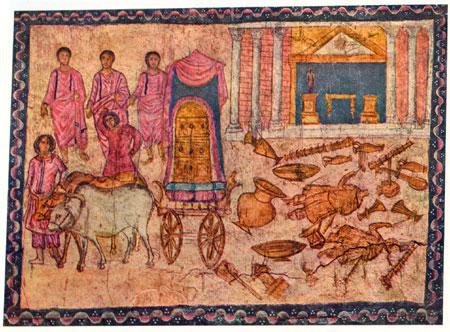
On the right, destruction and on the left an orderly procession of the Ark. As in the previous mural, two consecutive but contrasting events are framed in a single picture. As in the Mishkan paintings, we see a typical temple, but this time, it is the Philistine Temple of Dagon in Ashdod, where the Ark had been taken. It is a columned and gabled building, within which a pair of pedestals flank a table: one bears its idol, while the other, as if limping, has lost its deity. In fact, the fallen idol lies dismembered in front of the Temple, together with other cultic paraphernalia. A second dismembered idol represents the repeated upending of the same idol, emphasizing the defeat of the Philistine god by the God of Israel. The Ark of the Covenant, the symbol of God's presence, has zapped the pagan god.
How is God's role evident in the second half of this painting?
On the left side of the painting are five figures representing the five Philistine cities—two in Persian dress representing their priestly function and three in Hellenistic costume. They banish the Ark of the Covenant, transported on a wagon pulled by two milk cows. Why isn't the Ark being carried on poles, as in the preceding picture? The Philistine priests have set up a test using a wagon instead:
(ז) וְעַתָּ֗ה קְח֨וּ וַעֲשׂ֜וּ עֲגָלָ֤ה חֲדָשָׁה֙ אֶחָ֔ת וּשְׁתֵּ֤י פָרוֹת֙ עָל֔וֹת אֲשֶׁ֛ר לֹא־עָלָ֥ה עֲלֵיהֶ֖ם עֹ֑ל וַאֲסַרְתֶּ֤ם אֶת־הַפָּרוֹת֙ בָּעֲגָלָ֔ה וַהֲשֵׁיבֹתֶ֧ם בְּנֵיהֶ֛ם מֵאַחֲרֵיהֶ֖ם הַבָּֽיְתָה׃ (ח) וּלְקַחְתֶּ֞ם אֶת־אֲר֣וֹן יְהֹוָ֗ה וּנְתַתֶּ֤ם אֹתוֹ֙ אֶל־הָ֣עֲגָלָ֔ה וְאֵ֣ת ׀ כְּלֵ֣י הַזָּהָ֗ב אֲשֶׁ֨ר הֲשֵׁבֹתֶ֥ם לוֹ֙ אָשָׁ֔ם תָּשִׂ֥ימוּ בָאַרְגַּ֖ז מִצִּדּ֑וֹ וְשִׁלַּחְתֶּ֥ם אֹת֖וֹ וְהָלָֽךְ׃ (ט) וּרְאִיתֶ֗ם אִם־דֶּ֨רֶךְ גְּבוּל֤וֹ יַֽעֲלֶה֙ בֵּ֣ית שֶׁ֔מֶשׁ ה֚וּא עָ֣שָׂה לָ֔נוּ אֶת־הָרָעָ֥ה הַגְּדוֹלָ֖ה הַזֹּ֑את וְאִם־לֹ֗א וְיָדַ֙עְנוּ֙ כִּ֣י לֹ֤א יָדוֹ֙ נָ֣גְעָה בָּ֔נוּ מִקְרֶ֥ה ה֖וּא הָ֥יָה לָֽנוּ׃
(7) Therefore, get a new cart ready and two milch cows that have not borne a yoke; harness the cows to the cart, but take back indoors the calves that follow them. (8) Take the Ark of the LORD and place it on the cart; and put next to it in a chest the gold objects you are paying Him as indemnity. Send it off, and let it go its own way. (9) Then watch: If it goes up the road to Beth-shemesh, to His own territory, it was He who has inflicted this great harm on us. But if not, we shall know that it was not His hand that struck us; it just happened to us by chance.”
Two different elements comprise the test: will the cows abandon their lowing calves and will they go unattended straight to Israelite territory?
Our picture shows the Ark at a crossroad, responding to the second element,
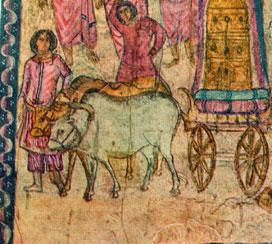
elaborated in a number of midrashim:
Some of the wise men and diviners answered. "Let us not try only this, but let us set the cows at the head of the three roads that are by Ekron. The middle road goes straight to Ekron, the right-hand one to Judaea and the left-hand one to Samaria. If they set out on the right-hand road and go straight to Judaea, we will know that truly the God of the Jews has destroyed us. But if they go forth by those other roads, we will know that a hard time has come upon us inasmuch as now we have denied our own gods."
Biblical Antiquities of Pseudo-Philo, Chapter 55
The other element of the test—the separation of the milk cows from their calves—elicits a musical midrash. The calves are lowing, but their mothers, the cows, having been programmed by God, cannot respond. Instead, the cows break into song, drowning out the voices of their calves:
ר' שמואל בר נחמני אמר (תהלים צג, א) ה' מלך גאות לבש ר' יצחק נפחא אמר רוני רוני השיטה התנופפי ברוב הדרך המחושקת בריקמי זהב המהוללה בדביר ארמון ומפוארה בעדי עדיים
Rabbi Shmuel bar Naḥmani says that it was the Psalm beginning: “The Lord reigns; He is clothed in majesty” (Psalms 93:1). Rabbi Yitzḥak Nappaḥa says: They did not recite a verse found in the Bible, but rather, the following song: Sing, sing, acacia; ascend in all your glory; overlaid with golden embroidery, exalted by the book [devir] of the palace, and magnificent with jewels. The song alludes to the Ark of the Covenant, which was made of acacia wood and covered with gold. The expression: Book of the palace, is a reference to the Torah scroll that was placed in the Ark.
This charming scene, however, is not illustrated at Dura, but like other Dura paintings, it comes about as a midrashic word play on the verb tisharna, literally "they went straight on". But the midrashic imagination reads the root yashar (straight) as shir (song). We can imagine all kinds of fun with this in class.
Finally, in our painting, we see two colorful cushions (rather than a box) beside the Ark. The explanation of this detail is found in Josephus' Antiquities of the Jews, where the rare biblical word argaz
(meaning "box" or "crate" in modern Hebrew) is translated as "bag". This is one of the many cases in which midrash helps us understand the paintings of Dura.
In summary, the humiliating capture of the Ark is avenged by the humiliating fall of Dagon's idols and makes a triumphal statement about the superiority of Judaism over paganism.
Why is this curious but marginal narrative of the capture and return of the Ark of the Covenant located so centrally in this particularly important part of the synagogue? Perhaps, the small Durene Jewish community sticks out its tongue at the folly of ancient pagans, as a way of disparaging their contemporary pagan neighbors. The broken sacra before the Temple of Dagon are modeled on Mithraic paraphernalia. The temple of Mithras, down the block from the synagogue, is identified with the pathetic temple of Dagon, in contrast with the glorious Temple. This leads us to one of the great puzzles of Dura.
The Temple
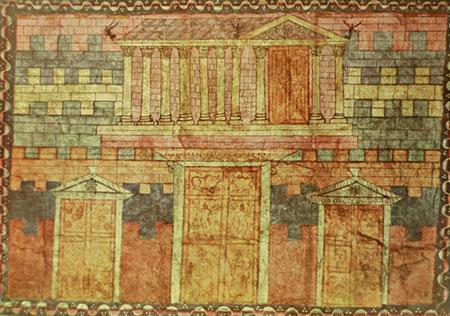
Obviously, this painting depicts a temple; but which temple is intended? Is it the Temple of Solomon, or the Second Temple or the future, messianic Temple? Or is it the celestial Temple of some mystical traditions? Past, future or visionary? All of these suggestions have been proposed by leading scholars.
We are still looking at the western wall of the synagogue. Having already found two parallel pairs of murals, we are not surprised to find another pair. The desert Tabernacle on the left parallels the Temple, on the right. Once again, their structures are remarkably similar: there are two levels in both – the lower level shows the three-gate entrance to the sacred precinct and the upper level is the holy building itself.

But on the left, the building is open, displaying the Ark of the Covenant and other Tabernacle furnishings, while on the right, the Temple is closed. While the Tabernacle has no foundations (because it is the Tent of Meeting), the Temple has four tiers of stonework below its massive columns. While the Tabernacle is surrounded by the hubbub of officiants and animals, the Temple, in stark contrast, is surrounded by seven multi-colored, silent walls. Some have seen this edifice as the celestial Temple at the center of the planetary spheres.
We suggest that this closed Temple is a composite of the Jerusalem temples of the past, in their pristine sanctity and monumentality. But for the Durenes, as we have been suggesting throughout, it is their shul, because the Jewish community of Dura Europos was mainly concerned with strengthening its own identity by associating itself with its biblical ancestors and by paralleling its synagogue to the ancient Tabernacle and Temples. There is no sacrificial activity around the Temple because the Temple is analogous to the Dura synagogue.
The Ark
We have now reached the focus of the second register, where the Ark of the Covenant appears five times.

The Torah Niche The Tabernacle Consecration The return from
from Philistia
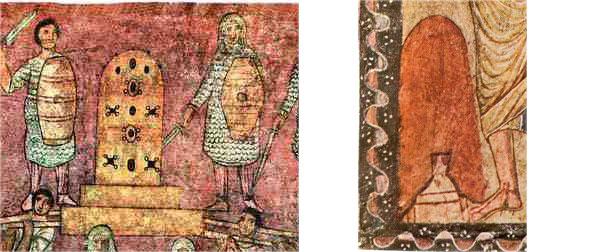
The captured Ark The covered Ark
The Ark is described precisely in the book of Exodus:
(י) וְעָשׂ֥וּ אֲר֖וֹן עֲצֵ֣י שִׁטִּ֑ים אַמָּתַ֨יִם וָחֵ֜צִי אׇרְכּ֗וֹ וְאַמָּ֤ה וָחֵ֙צִי֙ רׇחְבּ֔וֹ וְאַמָּ֥ה וָחֵ֖צִי קֹמָתֽוֹ׃ (יא) וְצִפִּיתָ֤ אֹתוֹ֙ זָהָ֣ב טָה֔וֹר מִבַּ֥יִת וּמִח֖וּץ תְּצַפֶּ֑נּוּ וְעָשִׂ֧יתָ עָלָ֛יו זֵ֥ר זָהָ֖ב סָבִֽיב׃ (יב) וְיָצַ֣קְתָּ לּ֗וֹ אַרְבַּע֙ טַבְּעֹ֣ת זָהָ֔ב וְנָ֣תַתָּ֔ה עַ֖ל אַרְבַּ֣ע פַּעֲמֹתָ֑יו וּשְׁתֵּ֣י טַבָּעֹ֗ת עַל־צַלְעוֹ֙ הָֽאֶחָ֔ת וּשְׁתֵּי֙ טַבָּעֹ֔ת עַל־צַלְע֖וֹ הַשֵּׁנִֽית׃ (יג) וְעָשִׂ֥יתָ בַדֵּ֖י עֲצֵ֣י שִׁטִּ֑ים וְצִפִּיתָ֥ אֹתָ֖ם זָהָֽב׃ (יד) וְהֵֽבֵאתָ֤ אֶת־הַבַּדִּים֙ בַּטַּבָּעֹ֔ת עַ֖ל צַלְעֹ֣ת הָאָרֹ֑ן לָשֵׂ֥את אֶת־הָאָרֹ֖ן בָּהֶֽם׃ (טו) בְּטַבְּעֹת֙ הָאָרֹ֔ן יִהְי֖וּ הַבַּדִּ֑ים לֹ֥א יָסֻ֖רוּ מִמֶּֽנּוּ׃ (טז) וְנָתַתָּ֖ אֶל־הָאָרֹ֑ן אֵ֚ת הָעֵדֻ֔ת אֲשֶׁ֥ר אֶתֵּ֖ן אֵלֶֽיךָ׃ (יז) וְעָשִׂ֥יתָ כַפֹּ֖רֶת זָהָ֣ב טָה֑וֹר אַמָּתַ֤יִם וָחֵ֙צִי֙ אׇרְכָּ֔הּ וְאַמָּ֥ה וָחֵ֖צִי רׇחְבָּֽהּ׃ (יח) וְעָשִׂ֛יתָ שְׁנַ֥יִם כְּרֻבִ֖ים זָהָ֑ב מִקְשָׁה֙ תַּעֲשֶׂ֣ה אֹתָ֔ם מִשְּׁנֵ֖י קְצ֥וֹת הַכַּפֹּֽרֶת׃ (יט) וַ֠עֲשֵׂ֠ה כְּר֨וּב אֶחָ֤ד מִקָּצָה֙ מִזֶּ֔ה וּכְרוּב־אֶחָ֥ד מִקָּצָ֖ה מִזֶּ֑ה מִן־הַכַּפֹּ֛רֶת תַּעֲשׂ֥וּ אֶת־הַכְּרֻבִ֖ים עַל־שְׁנֵ֥י קְצוֹתָֽיו׃ (כ) וְהָי֣וּ הַכְּרֻבִים֩ פֹּרְשֵׂ֨י כְנָפַ֜יִם לְמַ֗עְלָה סֹכְכִ֤ים בְּכַנְפֵיהֶם֙ עַל־הַכַּפֹּ֔רֶת וּפְנֵיהֶ֖ם אִ֣ישׁ אֶל־אָחִ֑יו אֶ֨ל־הַכַּפֹּ֔רֶת יִהְי֖וּ פְּנֵ֥י הַכְּרֻבִֽים׃ (כא) וְנָתַתָּ֧ אֶת־הַכַּפֹּ֛רֶת עַל־הָאָרֹ֖ן מִלְמָ֑עְלָה וְאֶל־הָ֣אָרֹ֔ן תִּתֵּן֙ אֶת־הָ֣עֵדֻ֔ת אֲשֶׁ֥ר אֶתֵּ֖ן אֵלֶֽיךָ׃ (כב) וְנוֹעַדְתִּ֣י לְךָ֮ שָׁם֒ וְדִבַּרְתִּ֨י אִתְּךָ֜ מֵעַ֣ל הַכַּפֹּ֗רֶת מִבֵּין֙ שְׁנֵ֣י הַכְּרֻבִ֔ים אֲשֶׁ֖ר עַל־אֲר֣וֹן הָעֵדֻ֑ת אֵ֣ת כׇּל־אֲשֶׁ֧ר אֲצַוֶּ֛ה אוֹתְךָ֖ אֶל־בְּנֵ֥י יִשְׂרָאֵֽל׃ {פ}
(10) They shall make an ark of acacia wood, two and a half cubits long, a cubit and a half wide, and a cubit and a half high. (11) Overlay it with pure gold—overlay it inside and out—and make upon it a gold molding round about. (12) Cast four gold rings for it, to be attached to its four feet, two rings on one of its side walls and two on the other. (13) Make poles of acacia wood and overlay them with gold; (14) then insert the poles into the rings on the side walls of the ark, for carrying the ark. (15) The poles shall remain in the rings of the ark: they shall not be removed from it. (16) And deposit in the Ark [the tablets of] the Pact which I will give you. (17) You shall make a cover of pure gold, two and a half cubits long and a cubit and a half wide. (18) Make two cherubim of gold—make them of hammered work—at the two ends of the cover. (19) Make one cherub at one end and the other cherub at the other end; of one piece with the cover shall you make the cherubim at its two ends. (20) The cherubim shall have their wings spread out above, shielding the cover with their wings. They shall confront each other, the faces of the cherubim being turned toward the cover. (21) Place the cover on top of the Ark, after depositing inside the Ark the Pact that I will give you. (22) There I will meet with you, and I will impart to you—from above the cover, from between the two cherubim that are on top of the Ark of the Pact—all that I will command you concerning the Israelite people.
According to this dense text, the Ark of the Covenant (aka Ark of the Testimony) was an open rectangular box, its height and width equal and its length 1.7 times longer. On top of this gold-coated wooden box was a solid gold cover, upon which stood two statuettes of the cherubim at either end. The Ark was carried using long, gold-covered poles inserted into rings on its sides.
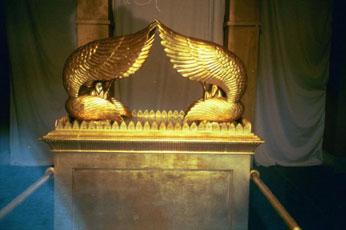
None of the five representations of the Ark bear any resemblance to the specifications in Exodus:
•They stand vertically rather than horizontally
•Their upper sections are rounded (or gabled, in other ancient
sources)
•There are no cherubim in evidence
•The poles are only occasionally shown
•The façades of the Arks are prominently decorated, unlike the
Exodus description
Obviously, the biblical description was available to the people of Dura Europos; why did they ignore this description and portray the Ark so differently?
Similar upright arks appear in Jewish art, from Israel and the Diaspora, during the Mishnaic and Talmudic period, contemporary with the Dura Europos paintings.
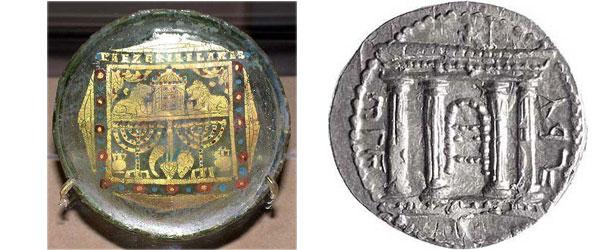
Gold glass, Israel Museum, 4th century Tetradrachma coin of the
Bar-Kochba revolt, 130
It turns out that this is the Torah Ark, central to every synagogue. It is indeed an upright closet, with shelves for the scrolls. In general, in the Diaspora, this ark was shown open, so that the foreshortened scrolls appear as small circles or squares; in Israel, the ark is usually closed. The top of the ark is either rounded or gabled. We suggest that it is modeled on the Roman bookcase, variously known as a scrinium—deriving from the word "scribere", "to write" and the source of the word shrine—or as an armarium, a closed bookcase.

"Temple of Diana" Sarcophagus of Mausoleum of
Nimes,1st century a Greek physician, Galla Placidia
Ostia, Ravenna,
early 4th century 5th century
On the left, in the courtyard of the "Temple of Diana" we see the frames of armaria as niches, alternately crowned by gables and arches. In the center, the detail from a 4th century sarcophagus shows an armarium containing scrolls. And on the right, a large, open armarium displays the books of the New Testament. The ubiquitous rounded and triangular ornaments found above entrances (closets, windows, doors) in classical architecture, appear repeatedly, even in the White House.

Thus, the artists at Dura picture the Ark of the Covenant not according to the account from Exodus, but on the model of their own Torah ark. By contrast, Christian artists relied on the Exodus account, having no similar object in their church experience.

Oratory of Germigny des Pres, St. Maria Maggiore, Rome,
806 5th c. century
The message of the shape of the Ark of the Covenant at Dura is continuity: as if they were saying, "Our Torah ark and the ancient Ark of the Covenant are one."
The Ark of the Covenant was apparently destroyed with the First Temple in 586 BCE. Even in First Temple times, the Ark was usually hidden from popular view. Its image had not, therefore, been accessible for the 800 years prior to Dura. Needing to actualize the ancient Ark, the Durenes portrayed scenes from the Tanakh 'dressed' in contemporary Hellenistic and Persian style, creating visual midrash, which closes the gap between the past and the present.
The Wing Panels
The last component of this register, at the very center of the synagogue's western wall, is a group of four vertical portraits, framing an obscure central panel. The portrait on the upper right is certainly the younger Moses' first encounter with God at the Burning Bush in Exodus 3. The upper left portrait, although damaged, seems to be Moses reaching up to receive the Tablets of the Law, Exodus 20.
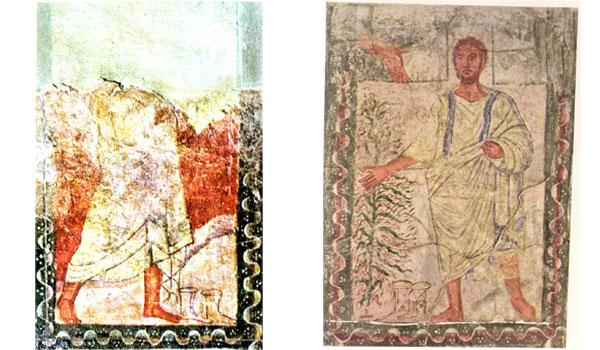
While there has been much debate about the identity of the two lower portraits,
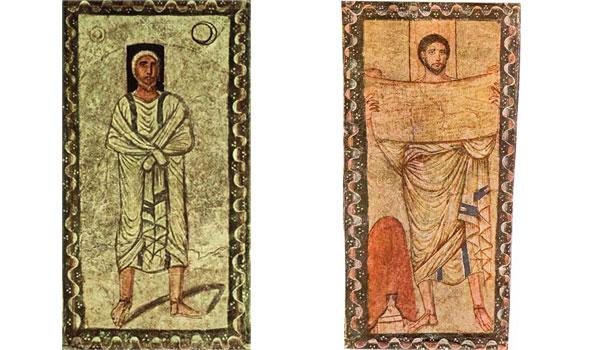
we suggest that all four are Moses, our Teacher. Our suggestion is based on a careful viewing of each portrait, consideration of the four portraits as a unit, and connection of the two lower portraits with the horizontal register dealing with the Tabernacle/Temple and the Ark. In any event, how does the centrality of these four portraits correlate with the Second Commandment, generally understood to prohibit images? In a pagan temple, the god's image would appear in exactly this location. But in the Dura synagogue, Moses is not an object of worship, but of reverence. Indeed, some Jewish and Christian opinions of the period read the Second Commandment not as a prohibition of all images, but only of their worship. Finally, Dura's visual culture significantly changed the way we formerly understood the Judaism of late antiquity, through literary sources alone.
Scroll and Ark
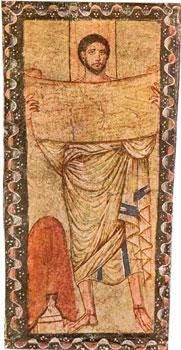
The lower right portrait shows a bearded figure wearing the teacher's himation and holding an uplifted, open scroll. A diminutive Ark of the Covenant, almost entirely covered, appears at his feet on the left side of the painting. The painting reflects the well-known passage from Exodus:
(ז) וַיִּקַּח֙ סֵ֣פֶר הַבְּרִ֔ית וַיִּקְרָ֖א בְּאׇזְנֵ֣י הָעָ֑ם וַיֹּ֣אמְר֔וּ כֹּ֛ל אֲשֶׁר־דִּבֶּ֥ר יְהֹוָ֖ה נַעֲשֶׂ֥ה וְנִשְׁמָֽע׃
(7) Then he took the record of the covenant and read it aloud to the people. And they said, “All that יהוה has spoken we will faithfully do!”
The nuanced Hebrew text emphasizes orality/aurality: Moses reads the Law literally "into the ears" of the assembly; they respond by saying literally, "we will do and we will hear". The painting shows Moses and the scroll, but where are the people of Israel? They are standing in the Dura shul, listening to the lesson!
But how can the Ark of the Covenant appear in a painting of Exodus 24, since it was not constructed until Exodus 37? As we have already discussed, the Durenes equated the Ark of the Covenant with the Torah ark. It therefore made perfect sense to them to show it in association with the reading of the Torah, especially in the context of the register which deals with the history of the Tabernacle/Temple and Ark. In each of its appearances in the register, the Ark wears a different hat: enthroned in the Tabernacle, embattled at Eben Ha-ezer, a treasure returned at Ashdod, a symbol of hope in association with the Akedah. Only in this portrait of Moses, is it simply the container of the Torah, shown in miniature in contrast to the large scroll of the Law being taught.
Sun, moon and stars
Each of the three preceding portraits follows the sequence of Moses' life: the first encounter with God, receiving the Law at Sinai, and the first public reading of the Torah. What is this fourth panel about?
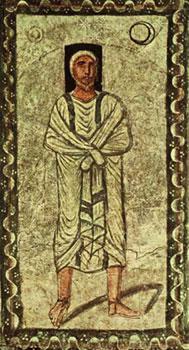
A man wearing a himation has wrapped his hands within his cloak. His hair and beard are white, against a black background. Sun, moon and stars are arrayed above him. Who is this and what text is illustrated? Suggestions range from Abraham counting the stars (Genesis 15), Jacob at Bethel (Genesis 28), Joshua stopping the sun and moon (Joshua 10) and Moses. If this is Moses, what is he doing? In view of the fact that the other three portraits sequence his life, this must be the final scene. But in Moses' final act in Deuteronomy 44, he views the Land of Israel (that he will never enter) from Mt. Nebo – no mention is made of the heavens or wrapped hands.
But midrash is unwilling to let him die like ordinary people. Instead, God takes him on a tour of the future world, the finale of which is Moses's ascension to the divine realm. The source of this painting then is a midrashic interpretation of the biblical passage
(ו) וַיִּקְבֹּ֨ר אֹת֤וֹ בַגַּי֙ בְּאֶ֣רֶץ מוֹאָ֔ב מ֖וּל בֵּ֣ית פְּע֑וֹר וְלֹא־יָדַ֥ע אִישׁ֙ אֶת־קְבֻ֣רָת֔וֹ עַ֖ד הַיּ֥וֹם הַזֶּֽה׃
(6) [God] buried him in the valley in the land of Moab, near Beth-peor; and no one knows his burial place to this day.
that suggests that in fact he was not buried on earth, but ascended to heaven (and compare Elijah's ascent in II Kings 2)!
The covered hands are a Roman convention: Roman soldiers presented their covered hands to the Emperor in order to receive their reward for services rendered. Moses' covered hands indicate that he is receiving a gift from his emperor, God.
In the past, scholars have observed the four portraits as a unit, but have not considered the two lower portraits in the horizontal context of the register in which they stand. If we consider this context, both lower portraits should have something to do with the history of the cult (Ark, Mishkan, temple). On the right, Moses reads from the Torah with the Ark at his feet. On the left, Moses ascends to the heavens. Having toured the Land of Israel in Deuteronomy, prior to his death, he gets an upgrade in the midrash, when God guides him through the celestial and terrestrial Temples.
The black square behind Moses' head would then indicate that he is
deceased, as in the midrash, which identifies him as משה רבנו עליו השלום, Moses our Teacher of blessed memory.
In summary, all temples are our shul, the Ark is our ark and Moses is our rabbi. There is no gap between the ancient sources and ourselves. This is the essence of midrashic thinking. The Jews of Dura are not afraid of portraying their biblical heroes, they are not lost in grief for the past nor obsessed with thoughts of the future or the cosmic. They declare in their art that they feel completely comfortable and at one with their Judaism.
Suggestions for classes based on this register:
• Redecorate your synagogue with images of your favorite bible figures and events, in modern dress.
• Re-enact the travels of the singing cows
• David brought the Ark to Jerusalem (II Samuel 7). Before reading the biblical account, write a short paragraph on what you see as a spectator. Next, draw a picture of what it looked like. How does the picture broaden your understanding of what you wrote? Now, read the biblical account and view some pictures of the scene. How are these renditions similar and different to your own? What is the connection between words and pictures?
For additional images on this subject see TALI Visual Midrash



